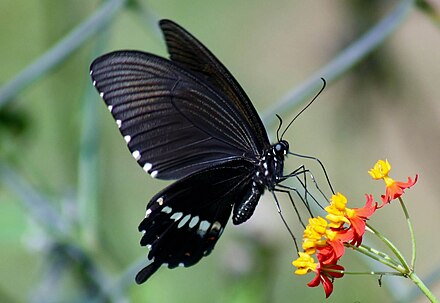Butterflies are a class of insects belonging to the order Lepidoptera, which also includes moths. They are easily identifiable insects, loved for their bright colors and the way they fly with flowers. There are approximately 170,000 known species of Lepidoptera worldwide, approximately 20,000 of which are butterflies. Butterflies not only play an important role in ecology, but are also a common theme in many cultural and artistic works.

Wings: Butterflies typically have large forewings and smaller hind wings, which are covered with colorful scales that create a unique pattern.
Natural enemies: Both larvae and adults have many natural enemies, including birds, spiders, insects, reptiles, etc.
Lifespan: The average lifespan of an adult is generally a few weeks, but some species are able to overwinter as adults and live until the following spring.
Food habits: Adult butterflies usually feed on nectar, while larvae (caterpillars) eat plant leaves. The larvae of some butterflies are specialized, eating only certain plants (such as many butterflies in the family Pieridae).
Habitat: Butterflies live in a variety of habitats, including tropical rainforests, deserts, grasslands, and boreal areas.
Migration: Some butterflies have migratory habits. The most famous example is the American Monarch butterfly, which can migrate thousands of kilometers.
Pollination: Many butterflies help plants reproduce by pollinating them as they feed.
Mating: Adult butterflies use visual and chemical signals to find a mate. After mating, the female lays eggs on food plants.
Life cycle: Butterflies have a complete metamorphosis process, including four stages: egg, larva (caterpillar), pupa (cocoon) and adult.
Threats: Major threats to butterflies include habitat loss, climate change and the use of agricultural chemicals.
Conservation: Some butterfly species are now listed as endangered or threatened, and conservation efforts include protecting habitats, growing butterfly food plants, and monitoring and studying butterfly populations.
Culture: Butterflies symbolize transformation, renewal, beauty and the lightness of life in many cultures.
Ornamental value: Butterflies often become popular guests in gardens because of their beauty and unique flight methods, and there are butterfly gardens set up specifically for viewing and studying butterflies.
Scientific research: In biology, butterflies serve as model organisms and are important for studying ecology, evolution, genetics and many other scientific fields.
Butterflies are widely studied for their unique biology and role in ecosystems, while their presence enriches human life and natural diversity. Protecting butterflies and their natural environment is a key part of maintaining biodiversity.
animal tags:
We created this article in conjunction with AI technology, then made sure it was fact-checked and edited by a Animals Top editor.